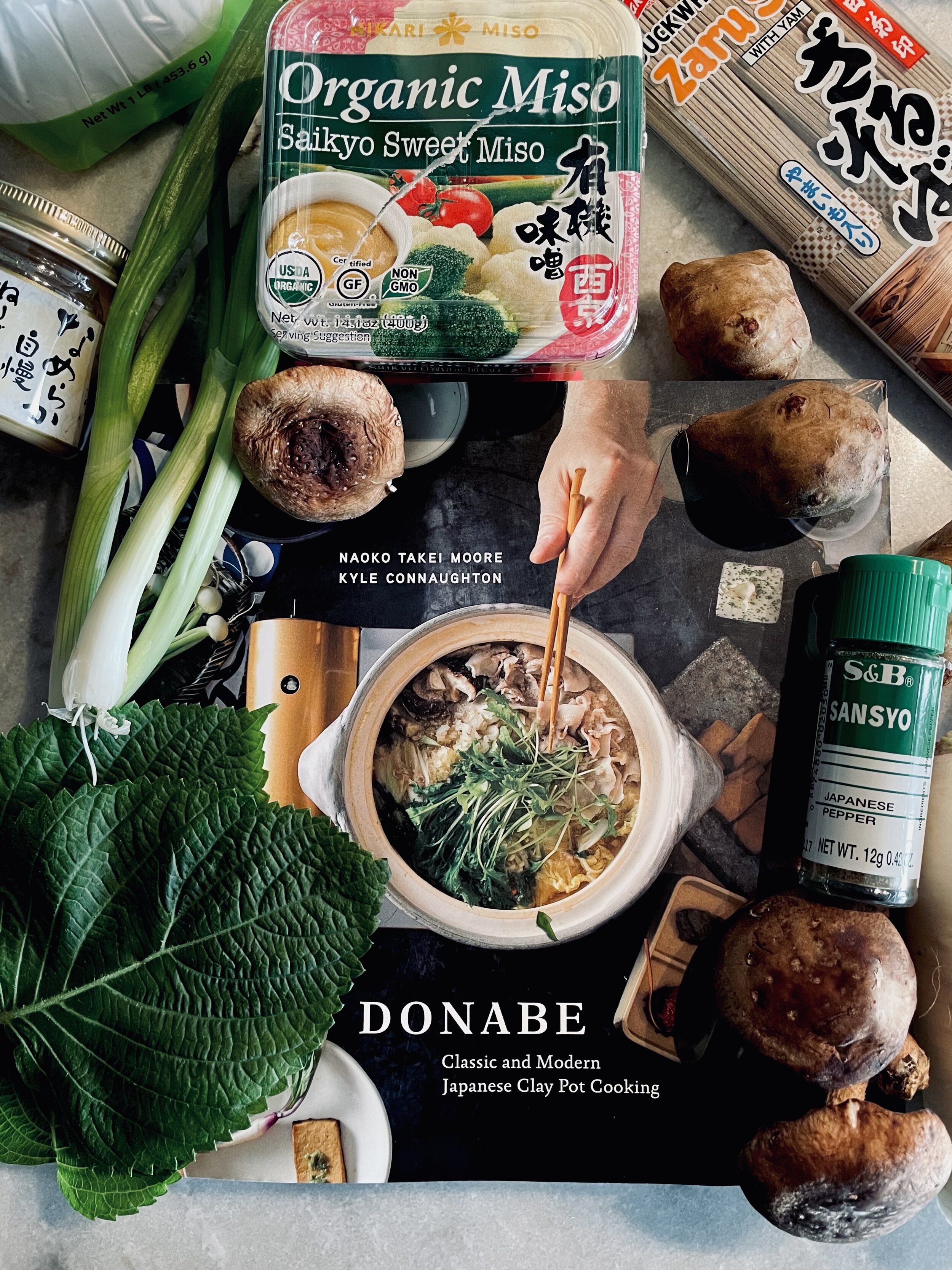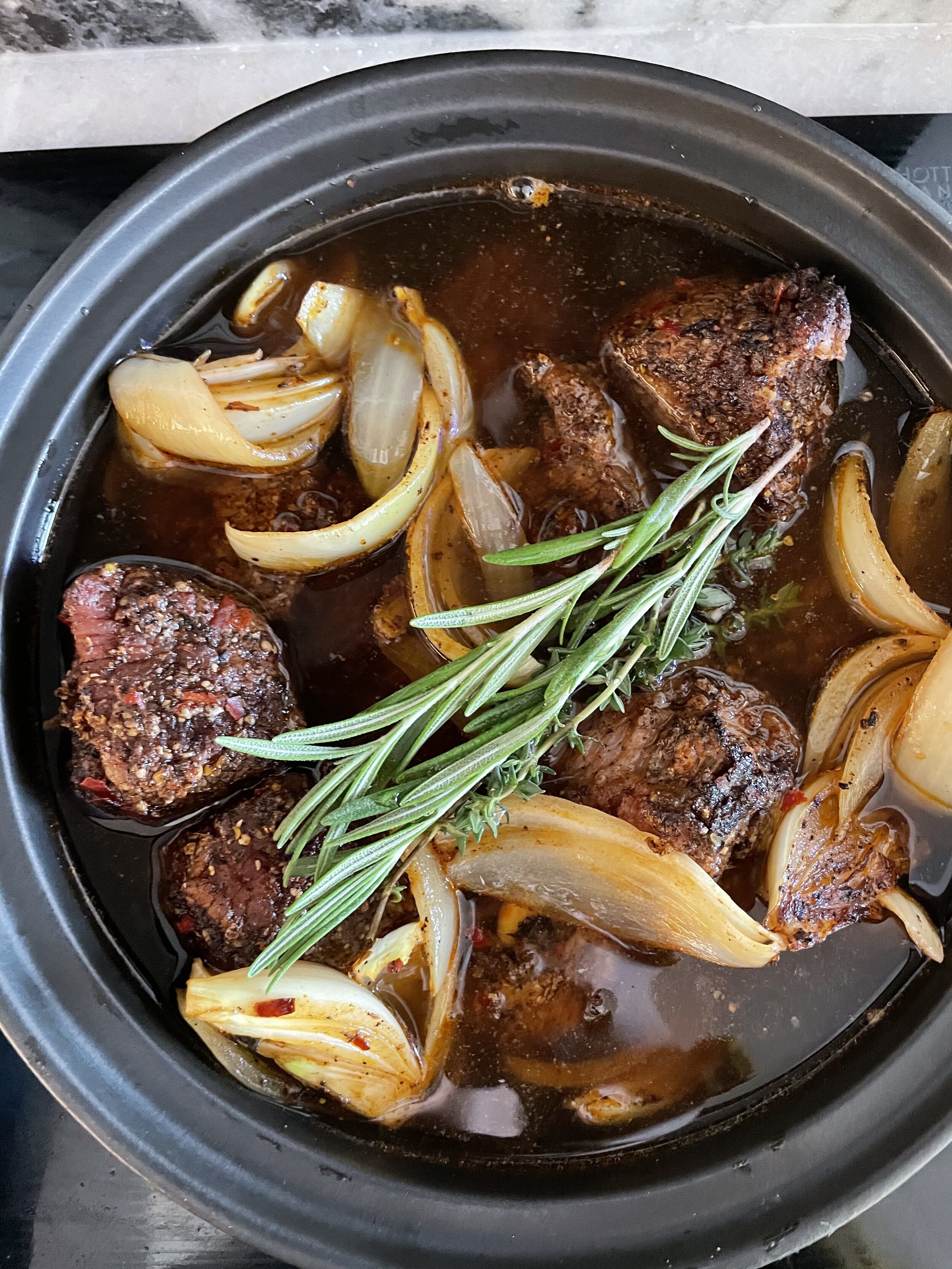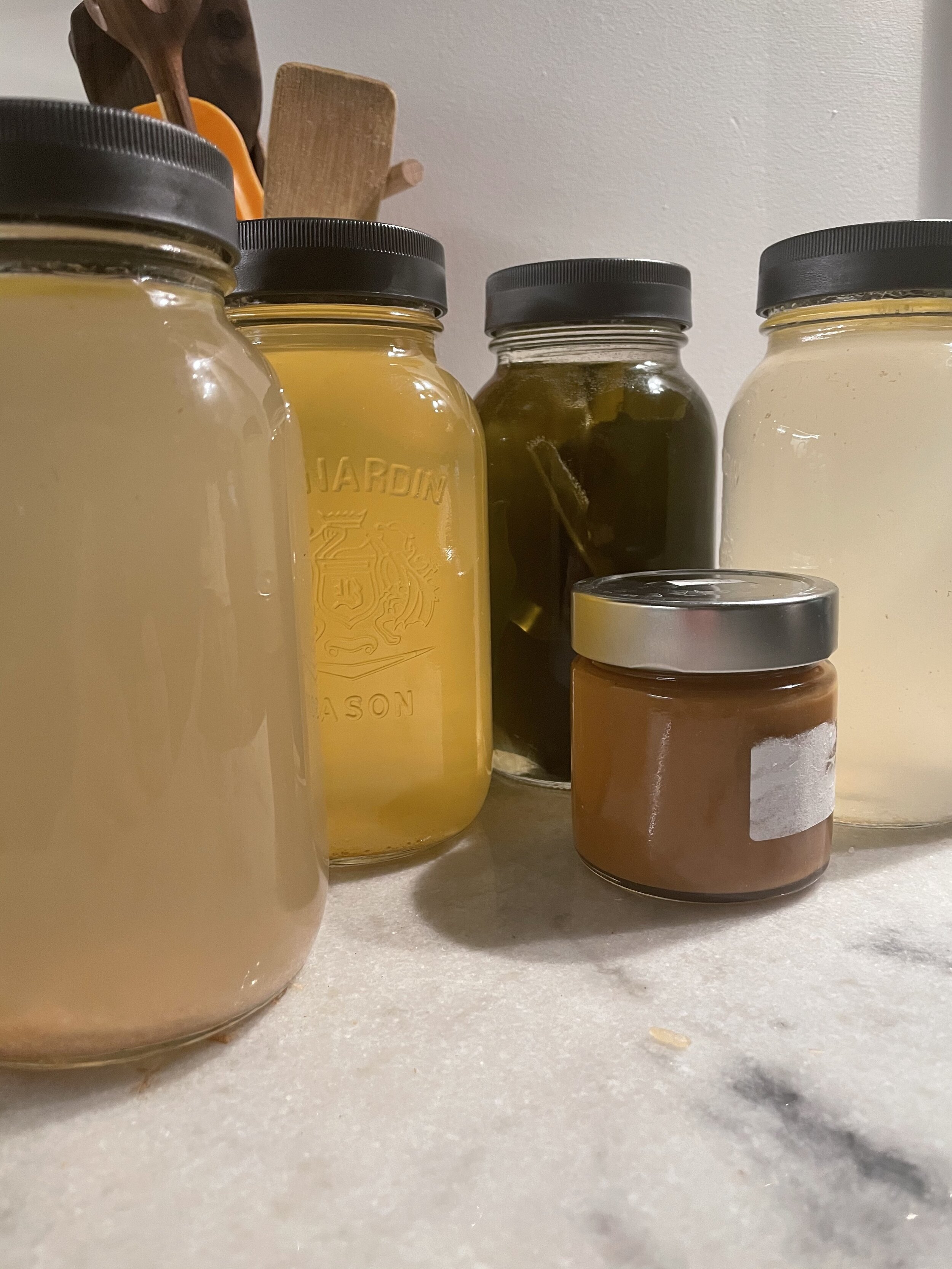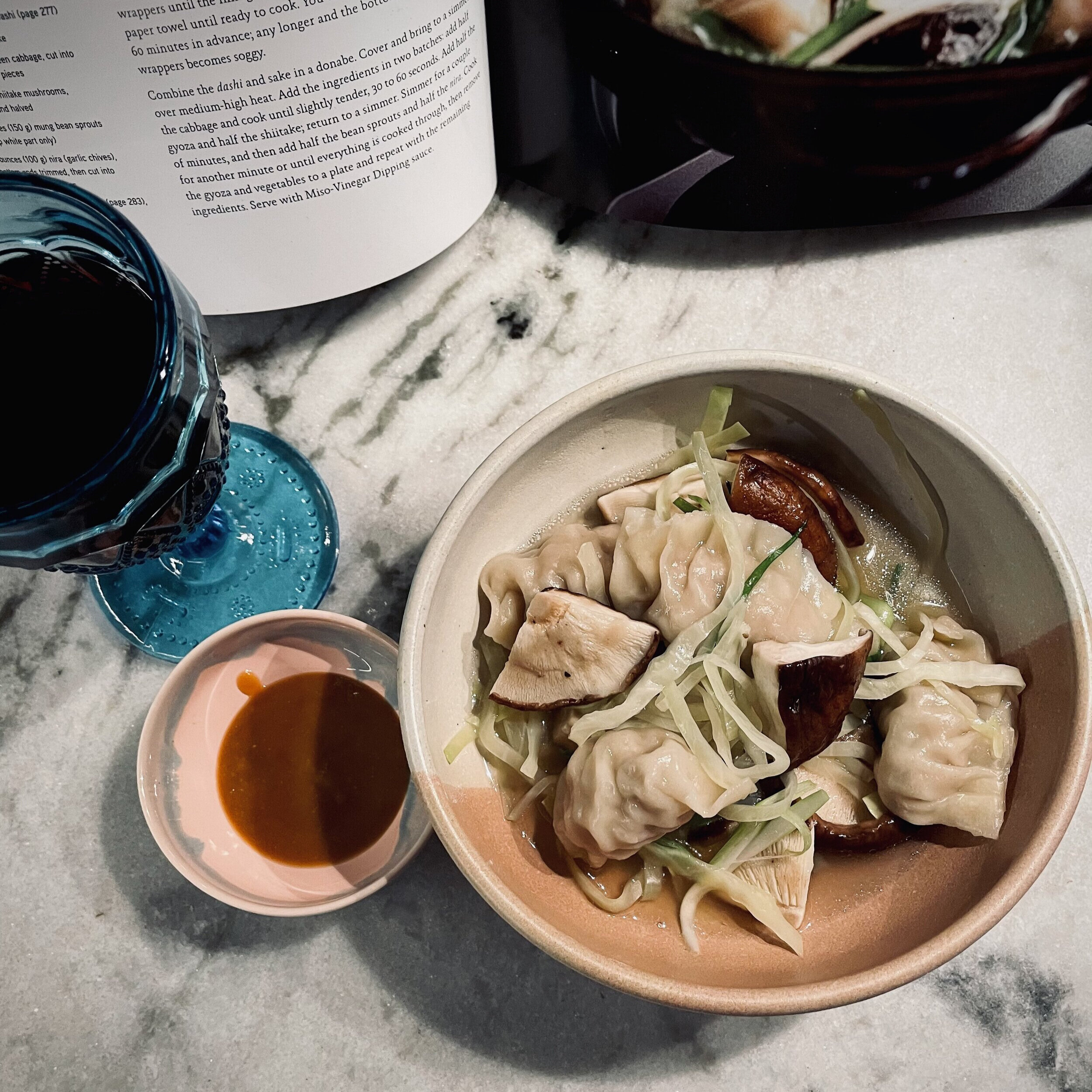
Tagines, smokers, and steamers
Donabe by Naoko Takei Moore & Kyle Connaughton
If you’ve ever shopped for or been inside a condo in a city like Toronto, you become blind to the general amenities you’ll find in the kitchen. Oven, stovetop (gas or electric or rarely induction) and a microwave. A fridge/freezer and a very essential dishwasher. When it comes to pots and pans, the standard Western kitchen has some saucepans, a pot for boiling water, maybe a skillet or a dutch oven. My cast iron skillet changed my cooking back in the mid 2000s when I learned about heat distribution and the perfect sear, as well as taking a pan from your cooktop directly into the oven. I got a tagine from my mother in law a decade ago and have been seasoning it with Ras al Hanout, olives, and preserved lemons since. The smells and flavours work their way into the clay of the tagine over time and give the food a flavour you can’t get just from ingredients. This year I got a small donabe and this cookbook on donabe cooking. I take for granted that an oven is a big metal thing in your kitchen cabinets that heats an enormous chamber. Like the tagine, the donabe is a little oven that can steam, smoke, confit, roast, and braise. Both vessels require very little heat to cook and season over time. Naoko Takei Moore (a.k.a. Mrs. Donabe) has dozens of donabes for different occasions. This book is work reading all the way through because there are descriptions of the different donabes and their uses as well as notes on shime (finishing courses), meal plans and ingredients. I can’t recreate that all here but I tried to guide you through it as best I could. Although you could do a lot of these dishes in a dutch oven, I recommend the investment in a donabe. After all, it’s much cheaper than a Maytag.
The recipes
A lot of the donabe recipes are cooked fresh, but you need to plan ahead to make sure you have all your stocks ready to go, and there are quite a few. I wanted to include more recipes from the back of the book under the “smoked” section but I haven’t got a donabe with a smoker so I needed to choose recipes more carfeully according to my equipment.
Prep
Miso-vinegar dipping sauce (p.283)
Kombu dashi (p.277)
Kombu & bonito dashi (p.?)
Salt-cured salmon (p.116)
Chicken dashi (p.278)
Coffee rub (p.174)
Basil-shiso puree (p.175)
Lunches
Steamed Yellowtail Shabu Shabu (p. 183)
Crab and Pork Shumai (p.199)
Salmon and Hijiki Rice (p.67)
Dinners
Braised Shio Koji Beef Brisket with sunchokes, radishes, celery, and coffee (p. 175)
Kyoto-Style Saikyo Miso Hot Pot (p.67)
Gyoza Hot Pot (p. 86)
Crab and Napa Cabbage Soup (p.259)

Shopping list
As always (I’m sorry) there is some upfront investment unless you already have a stocked Japanese pantry. In my experience with this meal plan and with the Tokyo meal plan there are a number of common ingredients that can be combined into a million different flavours: Soy sauce, mirin, sake, kombu, rice vinegar, miso, sesame oil, katsuobushi. Keeping these stocked (along with some white rice and noodles) ensures you can go from 0 to donabe in 30 minutes using the vegetables and meat you have on hand.
Vegetables & fruits
Small green cabbage
Carrot (1)
Head of brocolli
Russett potato (1)
Fresh ginger
Green onion
Shiitake mushrooms (3)
Mung bean sprouts (75g)
Breakfast radishes (3)
Lemons (3)
Orange (1)
Spinach (30g)
Cipollini onions (4)
Garlic
Shishito peppers (4)
Sunchokes (180g)
Celery
Daikon
Negi*
* I didn’t find this, so I used green onions instead
Spices
Red chile flakes
White sesame seeds
Smoked paprika
Yellow mustard powder
Aleppo pepper
Ground Ginger
Chili powder
Herbs
Rosemary
Thyme
Mitsuba*
Nira (garlic chives)*
Basil
Shiso (perilla) leaves
* I couldn’t find these, so I used substitutes or omitted them
Pantry
Saikyo miso
White sesame paste (or tahini)
Rice vinegar
Karashi
Katakuriko (potato starch)
Sake
Soy sauce
Sesame oil
Short grain white rice
Usukuchi shoyu (light-coloured soy sauce)
Dried hijiki seaweed
Kurozu (black vinegar)
La-yu (chile oil)
Yuzu ponzu
Finely ground coffee
Shio-koji
Raw brown sugar
Kombu
Katusobushi
Red miso
Mirin
Rice noodles
Ramen noodles
Dairy & Freezer
Butter
Soft tofu
Gyoza wrappers
Wonton wrappers
Pecorino
Eggs (2)
Meat & Fish
Pork belly (225g)
Ground pork (275g)
Salmon (100g)
Lump crabmeat (150g)
Beef brisket (225g)
Yellowtail fillet (225g)
Chicken wings (300g)
Prep (2 hours)
Start the Chicken Dashi (1L)
Season 600g chicken wings all over with the salt. Let the chicken marinate for 1 hour.
Start the Kombu and Bonito Dashi
Combine 2L water and about 20g kombu in a donabe or pot and let the kombu soak for 30 minutes.
Make the Kombu Dashi (1L)
Deja vu! In a bowl or pitcher, combine 1.3L (5 cups) water and 15g kombu. Cover and refrigerate for 18 to 24 hours. Remove the kombu.
Back to the Kombu and Bonito Dashi (1.8L)
Set the donabe, uncovered, over medium heat. Just before the broth comes to a simmer (after about 20 to 25 minutes) remove the kombu. Then, quickly turn up the heat to bring to a simmer, immediately turn off the heat. Add 30g katsuobushi all at once. Wait until the katsuobushi settles in the bottom of the donabe, about 2 minutes. Strain into a bowl through a fine mesh sieve lined with a double layer of damn cheesecloth or thin fabric. Let the dashi strain by gravity or press very gently. Don’t press hard or squeeze as this will give a fishy taste to the dashi. Cool and keep in the fridge for a few days.
Over to the chicken
Pat the chicken dry (or rinse and pat dry if there is any blood) and combine with 1 tsp sea salt, 1 negi or 2 green onions (green part only), 1 knob of ginger sliced into 3-4 pieces, 6 black peppercorns, and 1.2L (5 cups) water in the donabe (or pot). Cover and set over medium-high heat. As soon as the broth starts to boil, turn down the heat to simmer. Skim as necessary. Cover again and simmer for 20 minutes. Turn off the heat and let it rest for 15 minutes, or until the stock cools down (about 1 hour). Transfer the chicken wings to a bowl and save for another use. Strain the stock through a fine-mesh sieve.
Make the Miso-Vinegar Dipping Sauce
Whisk together 1/3 cup red miso, 1 tbsp Saiko or sweet white miso, 2 tbsp sake, 2 tbsp mirin, 2 tbsp raw brown sugar, 2 tbsp soy sauce, 1/4 cup rice vinegar, 1 clove garlic, finely grated, and 1 tsp finely grated peeled fresh ginger in a saucepan and set over medium-low heat. Bring to a gentle simmer and stir constantly with a wooden spatula for 2-3 minutes, or until slightly thickened and shiny. Take off the heat and let it cool down completely. Store in an airtight container.
Set the salmon to cure
Rub 1tbsp sea salt all over 200g skin on salmon fillet. Wrap with two layers of plastic wrap. Place the salmon on a tray and place another flat bottomed tray on top of the fish. Place something that weighs t to 2.5 pounds on the top tray. Refrigerate for 24 to 48 hours.
Make the rub for the shio-koji beef
Put 2 tbsp ground coffee, 1/2 tbsp paprika, 1/2 tbsp yellow mustard powder, 2 tbsp ground pepper, 1 tsp ground ginger, 1 tsp chili powder, and 2 tbsp aleppo pepper in a small container. Put on the lid and shake to combine. Store outside the fridge in a cool dark spot.
And the basil-shiso puree
Bring a large pot of water to a boil and prepare an ice bath. Blanch 1/2 cup loosely packed basil and 1/2 cup loosely packed shiso leaves for 3 seconds and transfer to the ice bath to cool. Drain and pat dry. Combine the leaves, 1/2 clove peeled garlic, 1 1/2 tbsp finely grated pecorino romano cheese, and a dab of shio-koji in a blender and puree until it resembles a chunky pesto, drizzling in 2-3 tbsp olive oil in a steady stream while blending. Store in the refrigerator.
Lunch
Salmon and Hijiki Rice
SakeHijiki Gohan
Soak 1 tbsp hijiki in an ample amount of water for 30 minutes. Make sure you don’t oversoak it so it starts to degrade. Take the seaweed out of the water, leaving any grit behind, and rinse in a colander in cold water.
In the donabe, combine 450ml short grain rice with 400ml Kombu and Bonito dashi, 2 tbsp sake, and 2 tsp usukuchi shoyu, and 2 tsp sesame oil. Spread the rehydrated hijiki over the rice and lay the salted salmon over top. Cover with a layer of foil and the lid (or, if you have a double donabe, cover with both lids). Cook on high heat for 13 to 15 minutes. Turn off the heat and let it rest undisturbed for 20 minutes.
Uncover, peel off the salmon skin (and any bones) and gently fluff by breaking up the fish with a spatula until all the components are mixed thoroughly. Serve in individual bowls with a wedge of lemon and some chopped mixed herbs such as daikon sprouts, green onion, or mitsuba, and some red pepper flakes.
I’ve given the instructions to make this in a donabe but I made it in a rice cooker. I added all the ingredients with the rice and put the salmon on top. Once the rice was finished, I took the skin of the salmon and flaked it in. As you can see, I couldn’t source hijiki seaweed so I sprinkled with furikake.
Crab and Napa Cabbage Soup
Heat 1/2 tbsp toasted sesame oil in the donabe over medium heat and sauté 3/4 tsp finely julienned ginger and 1/2 green onion, thinly sliced for a couple of minutes. Add 2-3 leaves medium green cabbage, cut into 1/2-inch strips, and 1 medium shiitake mushroom, thinly sliced. Sauté for 2-3 minutes.
Add 1 tbsp sake and 300ml Chicken Dashi and cover. As soon as the broth comes to a boil, turn down the heat to simmer. Simmer for 10 to 15 minutes, or until the cabbage is very soft.
While the soup is simmering get the tofu ready. Cut 200g soft tofu into cubes.
Season with 1/2 tsp salt and 1/4 tsp usukuchi shoyu. In a small bowl whisk 1/2 tbsp katakuriko (potato starch) with 3/4 tbsp water, and gradually stir the mixture into the broth. Stir until the broth is slightly thickened. Add 60g lump crabmeat and 30g spinach with the ends trimmed and leaves cut into 2-inch pieces. Gently add in the tofu.
As soon as the spinach is wilted, turn off the heat.
Serve with some sprinkles of black pepper, a splash of kurozu (black vinegar) and some La-yu (chile oil).
Steamed Yellowtail Shabu-Shabu and Orange Butter Rice
Buri no Mushi Shabu
To make the orange butter, cook 270ml short-grain white rice in a rice cooker. Using a paring knife or a peeler, slice off the zest from 1/2 an orange in long strips. Be sure not to get any of the white pith. Cut crosswise into very finely julienned pieces. Set aside.
Julienne 1 negi (or 3 green onions) and 150g daikon. Slice 225g yellowtail 1/4 inch thick. Prepare the donabe for steaming: fill the bowl up 70%. Line the steaming grate with the daikon. Cover and steam over upper medium-high heat for 1 to 2 minutes. Add the negi and spread over the daikon, followed by the fish. Cover and cook for 1 to 2 minutes or until the fish is medium rare. Don’t overcook the fish.
When the rice is cooked, add 1 1/2 tbsp butter, 1 1/2 tbsp usukuchi shoyu, and the orange zest. Gently fluff to combine. Serve with a crack of black pepper over top.
To serve, put 2 tbsp ponzu in little bowls for each person. Pick up the fish and vegetables and dip in the ponzu to enjoy. Serve with rice alongside. You can see from my photo I served it with noodles (after burning my rice) and some miso-soy vinaigrette.
Crab and Pork Shumai
Combine 90g lump crabmeat, 75g ground pork, 1/2 tbsp finely minced shallot, half a thinly sliced green onion, 1/2 tsp fresh grated ginger, 1/2 tbsp sake, 1/2 tsp light shoyu, 3/4 tbsp potato starch, a pinch of salt, a pinch of brown sugar and a pinch of white pepper. Knead by hand until smooth. Cover tightly with plastic wrap and let it rest in the refrigerator for 30 minutes.
Mound about 1 1/2 tbsp filling in the centre of a wonton wrapper. Gather up the edges of the wrapper, leaving the top of the filling open. Lightly squeeze the neck of the wrapper with your thumb and index finger to form pleats. Rub the bottom flat with your other hand. Set it on the tray and repeat the process with the remaining wrappers until the filling is gone. Cover with a damp paper towel until ready to cook. Don’t leave for more than 15-30 minutes or the bottoms will get soggy.
Line the surface of the steaming grate with lettuce, cabbage, or bean sprouts. Arrange the shumai on top, cover, and steam over upper medium-high heat for 6 to 8 minutes, or until the filling is cooked through.
To serve, put soy sauce and rice vinegar on the table for people to mix to their taste. The standard ratio is 1.5:1 soy sauce to vinegar. Serve with karashi on the side.
This is meant to be part of a multicourse meal, but we had it for lunch with a bit of scallion noodles. It would be nice with some rice and/or a green salad too.
I obviously didn’t wrap these properly but they still turned out great!
Dinner
Kyoto-Style Saikyo Miso Hot Pot
Saikyo Nabe
Cut 150g green cabbage into strips. Julienne 50g carrot and 120g russet potato. Cut 120g broccoli and 225g pork belly into bite-sized pieces.
To cook the vegetables and meat: Bring a medium pot of water to a boil and add a generous pinch of salt. Add cabbage and blanch until partly cooked but still crisp, about 30 seconds. Strain the cabbage out of the water and let it cool down. Using the same pot, repeat the process with the carrot, and then the broccoli. Finally, blanch the potato for 2 minutes, until slightly tender, and drain. Heat a sauté pan over medium heat and sauté the pork belly until the meat is just cooked through, 2 to 3 minutes. Transfer to a plate lined with paper towels to drain.
To make the broth: Pour 2 cups Kombu and Bonito Dashi into the donabe. Cover and set over medium-high heat. As soon as it starts to boil, turn down to a simmer. In a bowl, whisk together until smooth 150g Saikyo miso and 1 tbsp sesame paste with a ladleful of broth from the donabe, and then stir this into the donabe. Add the cabbage, potato, and pork belly side by side, followed by the broccoli and carrot, pushing them between the other ingredients. Cover and bring back to a summer and cook for another 3 to 5 minutes. Turn off the heat and drizzle with 3/4 tsp of unseasoned rice vinegar. Serve with Karashi on the side.
Cook some ramen noodles and add them to the broth as a finishing course.
Don’t sleep on the karashi here. This is a delicious soup, and the mustard just adds that extra boom.
Gyoza Hot Pot
Gyoza Nabe
To make the gyoza: Combine 200g ground pork with 1/2 tbsp katakuriko (potato starch), 3/4 tsp finely grated ginger, 1/2 tbsp sake, 1 tbsp minced green onion, 1/2 tsp toasted sesame oil, 1/2 tsp soy sauce, and a pinch of black pepper. Knead by hand until the filling is smooth and shiny. Cover with plastic wrap and let rest in the refrigerator for 30 minutes. To fill the gyoza, mound about 1 tbsp filling in the centre of a gyoza wrapper, and use water to wet the edges around half of the wrappers edge. Fold the wrapper in half by lifting the dry edged side. Pinch the edges tightly to seal and place the gyoza on a baking tray lined with parchment. Repeat until the filling is hone. Cover the dumplings with a damp paper towel until ready to cook. Don’t make these more than 60 minutes before serving or they will go soggy.
Combine 2 cups kombu dashi with 1/4 cup sake in a donabe. Add 2 leaves green cabbage, cut into large bite sized pieces and cook until slightly tender, 30 to 60 seconds. Add the gyoza and 3 medium shiitake mushrooms, trimmed and halved. Simmer for a couple minutes, then add 75g mung bean sprouts and 50g nira (garlic chives) trimmed and cut into 3-inch pieces. Cook for another minute or so until everything is cooked through, then serve with the prepared Miso-Vinegar Dipping sauce.
If you have broth left over, you can season with soy sauce or fish sauce and mirin to taste, then add cooked rice noodles and garnish with green onion.
Braised Shio-Koji Beef Brisket with Sunchokes, Radishes, Celery, and Coffee
This is an easy but time consuming stew. It needs to marinate for 1 hour and bake for 4. Plan ahead! I didn’t, and ended up ordering takeout and finishing the stew the next day.
Combine 225g beef brisket, cut into large-ish cubes with 4 cipollini onions, peeled and halved, 1 clove of garlic, thinly sliced, 1 1/2 tbsp shio-koji, 3/4 tsp Saikyo miso and 1 tbsp of the coffee rub and toss to coat evenly. Cover and refrigerate for at least 1 hour.
Heat a sauté pan over high heat and add the olive oil. Sear the beef on all sides until just browned (don’t crowd the pan, work in batches if you need to). Add the beef to the donabe. Add the onions to the pan and lower the heat to medium. Caramelize the onions for 3 to 5 minutes until deeply browned. Tie together 1 sprig of rosemary, 1 sprig of thyme, and 3 sprigs of mitsuba with a piece of twine. Transfer the onion and the bouquet of herbs to the donabe. Add 375ml of chicken stock an cover with the lid.
Preheat the oven to 350˚F (175˚C). Over medium heat on the stove top, bring the beef mixture to a low simmer. Transfer to the oven and cook for 1 hour.
Remove the donabe from the oven and skim any excess fat from the top. Add 3 breakfast radishes, halved or quartered lengthwise, 4 shishito peppers, stemmed, 180g sunchokes, sliced in the 1 1/2 inch slices, 1 rib of celery, sliced 1 1/2 inches thick, 1 tbsp shio-koji, 1/2 a tbsp soy sauce, and 1 tbsp yuzu or meyer lemon juice. Cover and return to the oven until both meat and veg are tender, about 3 more hours.
Remove the donabe from the oven. Uncover and stir in 2 tbsp of the basil-shiso puree. Crack 2 eggs and into the dish. Cover and set over medium-low heat. Cook for 3 to 5 minutes until the eggs have just set but the yolks are still runny. Serve in individual bowls at the table.
Lessons and leftovers
If you’re like me, you have a lot of miso sesame vinaigrette left over. You’re welcome. That sauce is one of the highlights of this meal plan and it made it into the Hall of Fame. I happen to also have a fridge full of dumpling so I am excited to work my through every last drop. I also have a lot of chicken stock, because I actually increased the recipe. Because there’s little prep in this meal plan, there’s also little leftover other than some fresh ingredients that were used sparingly, like the spinach and some fresh herbs. Along with the leftover spinach, I’m using the chicken stock to make some ricotta dumplings, and using the fresh herbs (thyme, rosemary) in a focaccia, which is my new favourite way to use up fresh herbs. I also have some extra gyoza and wonton wrappers that will not go to waste in the freezer.
There are some cookbooks that are more like lifestyle recipes and this is one of them. I found the other Japanese cookbook I dove into was the same. This is very different from cookbooks designed for entertaining like those in the Ottolenghi multiverse, which require specific ingredients that go stale in your pantry if you’re not careful. I am most of the way through the light soy sauce, misos, and sake I bought for this menu. I also have a new friend in karashi and la-yu. I learned to toss a little miso in a pasta sauce and whip up a quick hot pot broth. I also learned how easy it is to mix up some dumplings and the value of a little potato starch in the filling, or to thicken a soup broth. These are everyday comfort meals, and can be flexibly adapted to use what you have on hand. I really recommend picking up this book if you’re looking to get out of a home cooking rut. It will do the trick.









